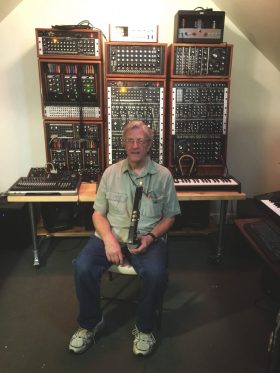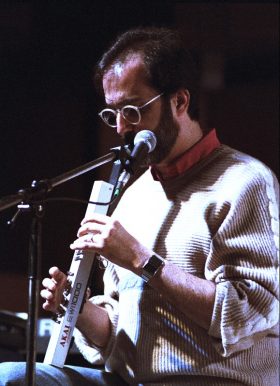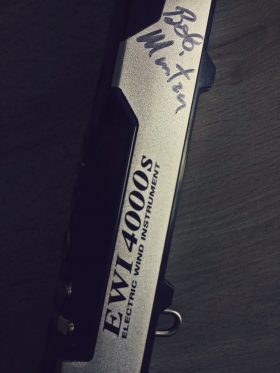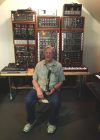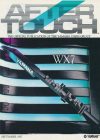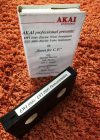VIDEO
watch, comment, subscribe
FORUM
read, learn, discuss
AUDIO
search, listen, rate
FOLLOW
photos, videos and more
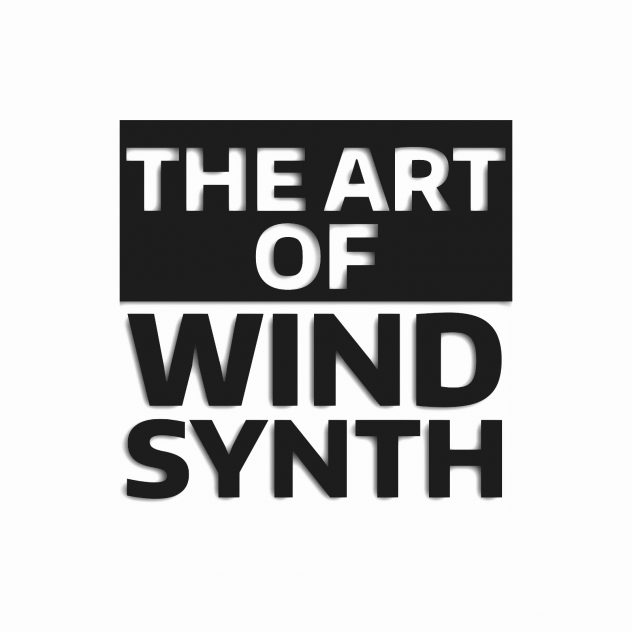
A wind controller, sometimes referred to as a „wind synth”, or „wind synthesizer”, is a wind instrument capable of controlling one or more music synthesizers or other devices. The basic concept that was to give birth to the first wind controller ( EVI – Electronic Valve Instrument ) began in 1964. Nyle Steiner, a trumpeter, music student, and engineering employee at an electronics firm, envisioned an electronic string instrument in which the string fingerings could be manipulated utilizing trumpet – fingering technique.
Steiner pointed out that: … the ultimate thing in the beginning was to make a trumpet interface so that any trumpet player could pick it up and say, „Hey, I can play the synthesizer now.” But that didn’t turn out to be practical, it turned out to be easier to learn some new techniques but have the instrument really be powerful. So, in certain ways, if we try to imitate all of a trumpet we also imitate some of its limitations.
Wind controllers are most commonly played and fingered like a woodwind instrument, usually the saxophone, with the next most common being brass fingering, particularly the trumpet. Models have been produced that play and finger like other acoustic instruments such as the recorder or the tin whistle. One form of wind controller, the hardware – based variety, uses electronic sensors to convert fingering, breath pressure, bite pressure, finger pressure, and other gesture information into control signals. Another form of wind controller uses software to convert the acoustic sound of an unmodified wind instrument directly into MIDI messages. In either case, the control signals or MIDI messages generated by the wind controller are used to control internal or external devices such as analog synthesizers or MIDI – compatible synthesizers, softsynths, sequencers, or even lighting systems. Since a wind controller usually does not make a sound on its own, it must be connected to a sound generating device such as a MIDI or analog synthesizer which is connected to an amplifier. For this reason, a wind controller can sound like almost anything depending on the capabilities of the connected sound generator. However, EWI models like the AKAI 4000S have a true sound output, as well as a MIDI output. The fingering and shape of the controller put no acoustic limitations on how the wind controller sounds. For example, a wind controller can be made to sound like a trumpet, saxophone, violin, piano, pipe organ, choir, or even a barnyard rooster.
In the early ’70s Lyricon designer Bill Bernardi, in what he calls „the passion of discovery”, declared: „The acoustic instrument is highly overrated as far as being 'a system in itself’ is concerned. The sound is not as important as the control over it.” The marketplace has not backed up his claims. What we all continue to demand from instrument manufacturers are great sounds, hi – fi quality samples, presets and push – button ease of use. Controls and performance systems have taken a low priority until recently. Such concepts as emotion, expression and intonation are often the sole preserve of the lead vocalist. Have we had to wait for synthesized timbres to reach the complexity of acoustic sound textures before such instrumental subtleties are worth worrying about ?. Or was it just bad luck ?. Wind synthesizers have been with us for a long time without having any real impact on the nature and sound of music. Sampling, drum machines, digital processing and low – cost multitrack, however, have transformed the business of music – making in a few short years. Is wind control of electronic sounds an idea whose time has finally come ?. Or is it a brief distraction from the trend towards easier, more accessible ways of instant music – making ?. It takes a long time to really play a musical instrument, so maybe time will tell … more information on WIKIPEDIA and PATCHMAN MUSIC.

A wind controller, sometimes referred to as a „wind synth”, or „wind synthesizer”, is a wind instrument capable of controlling one or more music synthesizers or other devices. The basic concept that was to give birth to the first wind controller ( EVI – Electronic Valve Instrument ) began in 1964. Nyle Steiner, a trumpeter, music student, and engineering employee at an electronics firm, envisioned an electronic string instrument in which the string fingerings could be manipulated utilizing trumpet – fingering technique.
Steiner pointed out that: … the ultimate thing in the beginning was to make a trumpet interface so that any trumpet player could pick it up and say, „Hey, I can play the synthesizer now.” But that didn’t turn out to be practical, it turned out to be easier to learn some new techniques but have the instrument really be powerful. So, in certain ways, if we try to imitate all of a trumpet we also imitate some of its limitations.
Wind controllers are most commonly played and fingered like a woodwind instrument, usually the saxophone, with the next most common being brass fingering, particularly the trumpet. Models have been produced that play and finger like other acoustic instruments such as the recorder or the tin whistle. One form of wind controller, the hardware – based variety, uses electronic sensors to convert fingering, breath pressure, bite pressure, finger pressure, and other gesture information into control signals. Another form of wind controller uses software to convert the acoustic sound of an unmodified wind instrument directly into MIDI messages. In either case, the control signals or MIDI messages generated by the wind controller are used to control internal or external devices such as analog synthesizers or MIDI – compatible synthesizers, softsynths, sequencers, or even lighting systems. Since a wind controller usually does not make a sound on its own, it must be connected to a sound generating device such as a MIDI or analog synthesizer which is connected to an amplifier. For this reason, a wind controller can sound like almost anything depending on the capabilities of the connected sound generator. However, EWI models like the AKAI 4000S have a true sound output, as well as a MIDI output. The fingering and shape of the controller put no acoustic limitations on how the wind controller sounds. For example, a wind controller can be made to sound like a trumpet, saxophone, violin, piano, pipe organ, choir, or even a barnyard rooster.
In the early ’70s Lyricon designer Bill Bernardi, in what he calls „the passion of discovery”, declared: „The acoustic instrument is highly overrated as far as being 'a system in itself’ is concerned. The sound is not as important as the control over it.” The marketplace has not backed up his claims. What we all continue to demand from instrument manufacturers are great sounds, hi – fi quality samples, presets and push – button ease of use. Controls and performance systems have taken a low priority until recently. Such concepts as emotion, expression and intonation are often the sole preserve of the lead vocalist. Have we had to wait for synthesized timbres to reach the complexity of acoustic sound textures before such instrumental subtleties are worth worrying about ?. Or was it just bad luck ?. Wind synthesizers have been with us for a long time without having any real impact on the nature and sound of music. Sampling, drum machines, digital processing and low – cost multitrack, however, have transformed the business of music – making in a few short years. Is wind control of electronic sounds an idea whose time has finally come ?. Or is it a brief distraction from the trend towards easier, more accessible ways of instant music – making ?. It takes a long time to really play a musical instrument, so maybe time will tell … more information on WIKIPEDIA and PATCHMAN MUSIC.
What People Are Saying
„Who is the player ?, very nice „touch” – Eli Benacot
„Greetings from Seattle!. Just wanted to drop a note and say thanks for this page!. Its great to see some innovative work being done on such a unique instrument. Cheers!” – Greg Sinibaldi
„Thank you, allways great postings you do!” – Roland Graf
„WoW!, Thank you so much for your work on these patches Lukasz!” – Marty Howe
„These patches really are the perfect place to start for anyone with even the slightest interest in wind synth sounds” – Thorleif Markula
„I tried some of the sounds. Nice work. It’s a great way to introduce Serum to EWI players” – Seamus Blake
„Falcon would not have been worth buying without your presets!” – Derrick Roy Walker
„Every patch allows for incredibly nuanced playing, and there’s a sound for every situation, 100% would recommend” – Stef Haynes
„Holy moly that was really good emulated clarinet and really good played to …” – Andreas Glimstrand
„Such a beautiful patch, I can’t believe that’s the Mopho!” – Rob Neal Christian

